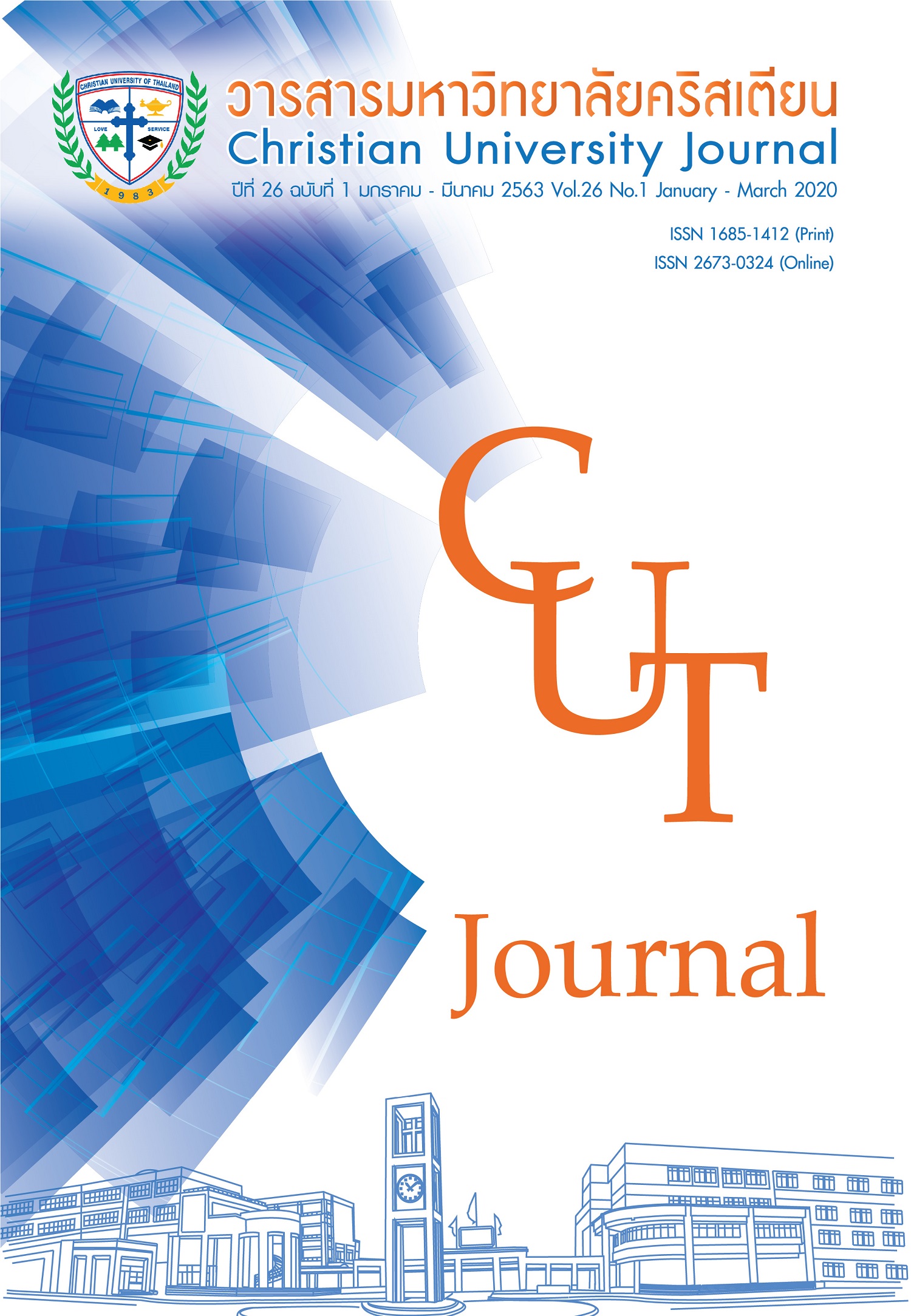การประเมินคุณภาพการบริการในธุรกิจสปาแบบ 2 มิติ : มิติจากความรู้สึกของลูกค้าและมิติความเห็นเชิงข้อเท็จจริง
คำสำคัญ:
การประเมินลูกค้า, คุณภาพการบริการ, ธุรกิจสปาบทคัดย่อ
คุณภาพการบริการเป็นองค์ประกอบที่สำคัญสำหรับธุรกิจสปาในการให้บริการที่สอดคล้องกับความคาดหวังและความพึงพอใจของลูกค้า อย่างไรก็ตามที่ผ่านมา ทั้งผู้ประกอบการธุรกิจสปาและนักวิชาการดูเหมือนจะเข้าใจในทำนองเดียวกันว่า การประเมินคุณภาพการบริการมาจากการประเมินความรู้สึกส่วนตัวของลูกค้าเพียงมิติเดียว (personal feeling) แต่แท้จริงแล้ว คุณภาพการบริการยังสามารถแบ่งออกเป็นมิติที่วัดจากความเห็นเชิงข้อเท็จจริงได้อีกด้วย (fact-based opinion) ดังนั้น การประเมินคุณภาพการบริการให้รอบด้านโดยผสมผสานการประเมินจากการวัดความรู้สึกส่วนตัวของลูกค้ากับความเห็นเชิงข้อเท็จจริง จะให้ข้อมูลและเสียงสะท้อนกลับที่มีความชัดเจนและรอบด้านมากกว่า ซึ่งจะช่วยให้ผู้ประกอบการธุรกิจสปาสามารถพัฒนาหรือปรับปรุงคุณภาพการบริการได้อย่างตรงจุด บทความนี้จึงมีวัตถุประสงค์เพื่ออธิบายเพิ่มเติมเกี่ยวกับการประเมินคุณภาพการบริการโดยแบ่งออกเป็น 2 มิติ คือ การวัดความรู้สึกส่วนตัวของลูกค้า (subjective assessment) และการสอบถามความเห็นเชิงข้อเท็จจริง (objective assessment) เพื่อเป็นประโยชน์และให้ความรู้ความเข้าใจที่ลุ่มลึกและชัดเจนขึ้นสำหรับการประเมินคุณภาพการบริการในธุรกิจสปา รวมทั้งอาจประยุกต์ใช้แนวคิดนี้ในธุรกิจบริการอื่นที่เกี่ยวข้อง ผู้ประกอบการธุรกิจบริการที่ประยุกต์ใช้การประเมินคุณภาพการบริการทั้ง 2 มิติ จะมีศักยภาพและโอกาสในปรับปรุงคุณภาพการบริการเพื่อตอบสนองความพึงพอใจของลูกค้าได้มากยิ่งขึ้น
เอกสารอ้างอิง
Akbar, S. (2013). Relationship of service quality and customer loyalty through the moderating effect of socio demographic characteristics. International Journal of Hospitality and Tourism System, 6(2), 81-91.
Boyle, P. & Lathrop, E.S. (2013). The value of private label brands to U.S. consumers: An objective and subjective assessment. Journal of Retailing and Consumer Services, 20, 80-86.
Chang, W., Li, K., Huang, Y., Filiaggi, A., & Courtney, T. (2004). Assessing floor slipperiness in fast food restaurants in Taiwan using objective and subjective measures. Applied Ergonomics, 35, 401-408.
Cambridge Dictionary. (2020). Cambridge international dictionary of English. Retrieved from https://dictionary.cambridge.org/
Cevik, H. & Simskek, K. (2017). The quality of five-star hotel animation services in Turkey with regard to tourists’ demographics. TOURISM, 65(3), 280-293.
Chieochankitkan, A. (2013). Developing service quality for spa establishments in the active beach tourism cluster, Thailand. (Doctoral dissertation), National Institute of Development Administration, Bangkok.
Chieochankitkan, A. & Sukpatch, K. (2014). The Customers’ perception of service quality for spa establishments in the Active Beach Tourism Cluster, Thailand. Silpakorn University Journal of Social Sciences, 14(3), 53-75.
Chigot, P. (2005). Effects of sound in offices: subjective experience vs objective assessment. Facilities, 23(3), 152-163.
Choi, Y., Kim, J., Lee, C., & Hickerson, B. (2015). The role of functional and wellness values in visitors’ evaluation of spa experience. Asia Pacific Journal of Tourism Research, 20(3), 263-279.
Corbin, C. B. & Pangrazi, R.P. (2001). Toward a uniform definition of wellness: A commentary present’s council on physical fitness and sports. Research Digest, 3(15), 1-8.
Day Spa Association (2008). Spa definition and guidelines. Spa Management, 18(2), 14-14.
Dimon, A. (2013). Wellness Travel: 10 Trends for 2014 and Beyond. Retrieved from https://www.travelmarketreport.com
Dianat, I., Vahedi, A., & Dehnavi, S. (2016). Association between objective and subjective assessments of environmental ergonomic factors in manufacturing plants. International Journal of Industrial Ergonomics, 54, 26-31.
Gonzalez, M.E. & Brea, J. A. (2005). An investigation of the relationship among service quality, customer satisfaction and behavioral intentions in Spanish Health Spas. Journal of Hospitality & Leisure Marketing, 13(2), 67-90.
Han, H. & Hwang, J. (2013). Multi-dimensions of the perceived benefits in medical hotels and their roles in international travelers’ decision making process. International Journal of Hospitality Management, 35, 100-118.
Hashemi, S., Jusoh, J., Kiumarsi, J., & Mohammadi, S. (2015). Influence factors of spa and wellness tourism on revisit intention: The mediating role of international tourist motivation and tourist satisfaction. International Journal Research-Granthaalayah, 3(7), 1-11.
International Spa Association (2012). U.S. Spa industry study. Lexington, Kentucky: International Spa Association.
Kiatkawsin,K. & Han, H. (2017). An alternative interpretation of attitude and extension of the value–attitude–behavior hierarchy: The destination attributes of Chiang Mai, Thailand. Asia Pacific Journal of Tourism Research, 22(5), 1-20.
Klaysung, C. (2016). Behaviors and factors affecting the selection of spa services among consumers in Amphawa, Samut Songkhram, Thailand. International Journal of Social and Tourism Sciences, 10(2), 897-901.
Kong, G., Jiang, L., Yin, X., Wang, T., Xu, D., Yang, J., & Hu, Y. (2018). Combining principal component analysis and the evidential reasoning approach for healthcare quality assessment. Annals of Operations Research, 271(2), 679-699.
Lewis, R.C. & Booms, B.H., (1983). The marketing aspects of service quality. Emerging perspectives on services marketing, 65(4), 99-107.
Liu, N., He, Y., & Xu, Z. (2019). Evaluate public-private-partnership’s advancement using subjective and objective information from stakeholder perspective. Technological and Economic Development of Economy, 25(3), 386-420.
Lo, A., Wu, C. & Tsai, H. (2015). The impact of service quality on positive consumption emotion in resort and hotel spa experiences. Journal of Hospitality Marketing & Management, 24, 155-179.
Memarzadeh, F. & Chang, H.J. (2015). Online consumer complaints about Southeast Asian luxury hotels. Journal of Hospitality Marketing & Management, 24, 76-98.
Ministry of Public Health. (2019). List of registered health establishments. Nonthaburi: Ministry of Public Health.
Nanu, I. & Staiculescu, A.R. (2019). Objective VS. Subjective in the human resources evaluation process. Business Intelligence, 14, 95-104.
Parasuraman, A., Zeithaml, V.A., & Berry, L.L. (1988). SERVQUAL: A multiple-item scale for measuring consumer perceptions of service Quality. Journal of Retailing, 64(1), 12-40.
Quintela, J., Costa, C., & Correia, A. (2016). Health, wellness and medical tourism: A conceptual approach. Enlightening Tourism. A Pathmaking Journal, 6(1), 1-18.
Rasdi, R., Ismail, M., & Garavan, T. (2011). Predicting Malaysian managers’ objective and subjective career success. The International Journal of Human Resource Management, 22(7), 528–549.
Sangpikul, A. (2019). The analysis of customers’ e-complaints and service quality at spa services in Thailand. e-Review of Tourism Research, 5(6), 45-62.
Sundbo, J. & Darmer, P. (2008). Creating experience in the experience economy. Cheltenham, England: Edward Elgar.
Tamagni, L., Micheli, E., & Zanfardini, M. (2003). Multidimensional scaling analysis in the determination of hotel quality dimension - Patagonia, Argentina. Journal of Quality Assurance in Hospitality & Tourism, 4(1), 111-128.
Veazie, J. (2010). Why you need to understand medicare appeals. Health Care Collector, 24(4), 7-11.
Weii , X., Meng, F., & Zhan, P. (2017). Chinese citizens’ outbound destination choice: objective and subjective factors. International Journal of Tourism Research, 19, 38-49.
Wuttke, M. & Cohen, M. (2008). Spa retail. In M. Cohen & G. Bodeker (Eds.), Understanding the global spa industry: Spa management (pp.208 – 220). Oxford, England: Butterworth-Heinemann.
Zehrer, A., Smeral, E., & Hallmann, K. (2017). Destination competitiveness—A comparison of subjective and objective indicators for winter sports areas. Journal of Travel Research, 56(1), 55-66.



